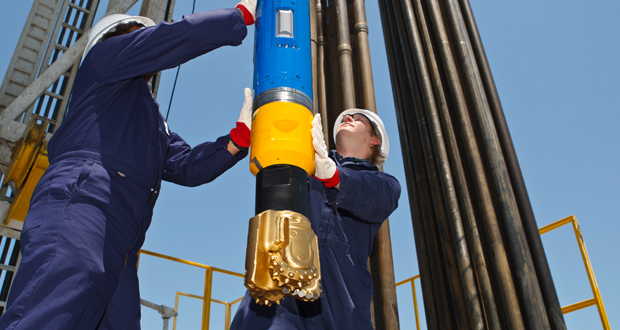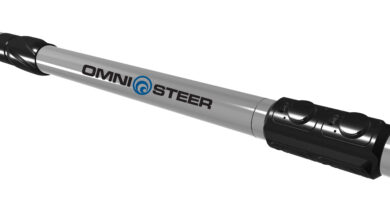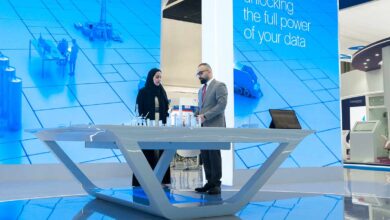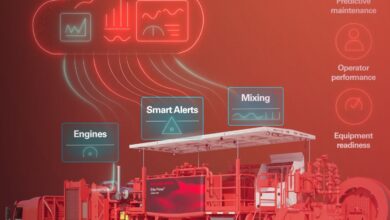Middle East wells confirm high build-rate rotary steerable system

New system incorporates pads that provide larger contact area with borehole walls, shorter three-point geometry for tighter curvatures
By Ahmed Al-Essa, Mohammed Al-Naabi, Alex J. Forest, Baker Hughes

Since the late 1990s, rotary steerable systems (RSS) have revolutionized drilling and redefined how far directional drilling can go. Extended-reach drilling, multilaterals and deepwater drilling have been brought up to new levels of efficiency. Well placement has also been enhanced, enabling reservoir navigation to be executed with outstanding net-to-gross results. However, the limitation of build-up rate capabilities, often around 6.5°/100 ft, has in cases forced planning to be changed to fit within the limitations.
The rise of shale drilling brought new development in RSS. There was a need to stay within lease lines, yet drill the longest possible laterals. In response, a new RSS was developed with build-rate capabilities up to 15°/100 ft. In some wells, this system has allowed the vertical, curve and lateral sections to be drilled in one run.
Operators in conventional applications have caught on to the idea of higher build-rate drilling since then. In these plays, drilling higher build-rate curve sections means reducing drilling footage, avoiding directional work in problematic formations and, ultimately, saving time.
Additionally, the high build-rate capability means changes in geological structure can be reacted to faster.
The Baker Hughes AutoTrak eXact high-build rate RSS was developed primarily for conventional markets, where there’s a need for high build rates simultaneous with acquiring LWD data. The use of a high build-rate RSS in conjunction with an optimized BHA for build-rate capability allows operators to drill build-up rates up to 12°/100 ft.
The new system was introduced in September 2014 and has been used on multiple wells in the Middle East and North America, including in formations that are extremely soft and unconsolidated.
Design
The AutoTrak Curve high build-rate RSS was the basis of design for the AutoTrak eXact. To develop a high build-rate RSS that is also compatible with LWD and formation evaluation (FE) services, the product development team was faced with two challenges. First, an RSS steering unit that can communicate with the LWD/FE equipment outside the AutoTrak Curve platform needed to be developed and integrated. Second, LWD/FE equipment typically could handle doglegs only up to 6.5°/100 ft due to their inherent design and physics.
Further development work was carried out on the AutoTrak Curve steering unit, making it fully compatible with the company’s suite of LWD/FE products. The development included communication adaptation and extensive platform integration testing.
To address the LWD/FE compatibility with higher dogleg severities (DLS), extensive finite element analysis was carried out on a multitude of BHAs. As a result, a recommendation of standard BHAs that were optimized for higher build rates and DLS was generated.
To deliver higher build rates, the RSS steering unit was redesigned, incorporating a new pad design and shorter three-point geometry. The new pads had a larger contact area with the borehole walls, thus were able to exert higher forces to bend the BHA in the desired direction and deflect the drill bit when needed. The three-point geometry was shortened by bringing the pads closer to the bit and integrating the third point stabilizer in the steering unit. A shorter three-point geometry results in tighter curvatures, hence the higher build rate capability.
Case 1: Delivering in Varying Formations

In late 2014 in the Middle East, a field trial was conducted with the new RSS. The operator’s challenge in this trial was the ability to kick off wells from vertical in a predefined direction and deliver consistent build rates above 7°/100 ft until the well was landed.
The obstacle of achieving desired build rates was significant because the build-up section went through several formations, some of which were quite soft. In the past, there was a need to limit ROP to achieve the desired build. The new system eliminated that difficulty, saving at least two days per well.
The objectives in this application were to drill the shoe, kick off to the west, maintain a 3° tangent for the placement of an electrical submersible pumping (ESP) system, then kick off the curve section, maintaining build rates above 7°/100 ft while simultaneously drilling at an average ROP above 35 ft/hr. Due to the integrated stabilizer in the RSS, the operator was also able to take advantage of a decreased distance to the formation evaluation tools. The survey sensor and FE sensors were all shifted closer to the bit by eliminating the need for additional subs in the BHA.
All goals were achieved. The tool precisely held a 3° tangent section in the planned azimuth direction, allowing the ESP to be set in an unhindered section of casing. In addition, the required 35 ft/hr ROP was maintained and even exceeded through some formations. Build rate capabilities were maintained above 8°/100 ft in challenging formations.
In other formations, build rate capability was observed to be more than 10°/100 ft, requiring applied forces at the rotary steerable tool to be reduced to avoid higher DLS than planned. This force change was adjusted while drilling on bottom with the Baker Hughes Bypass Actuator system. As a result, no downtime was required to adjust tool parameters.
For future wells, the increase in delivered build rate capabilities will allow the operator to plan for shorter curve sections and a longer exposure to the pay zones. Time savings is estimated to be three days, including an additional possible trip, equal to a savings of approximately $120,000. In addition, a smooth wellbore will allow trouble-free trips and casing runs.
Case 2: Unconsolidated Formations
An operator in the Middle East was faced with a challenging drilling campaign in an extremely soft, unconsolidated sand formation. The geological target was tight, with uncertainty and potential faults. The operator’s objective was to drill as quickly as possible in a tight window, allowing a deviation of only 3 ft above and 2 ft below the line with a lateral deviation of 33 ft to the left or right of the line.
The operator also wanted to perform open-hole sidetracks using the same assembly in the same run to maximize reservoir contact.
The new RSS was deployed on these wells, with the bit and BHA fully analyzed and optimized for the objectives. As a result, 3,600 ft of horizontal section was drilled in two planned laterals. From a geological perspective, both laterals were placed 100% within the target and maintained well trajectories as per the well plan. The entire drilling time for both sections, including sidetracking, was less than 19 hrs.
On previous wells in this field, this took up to two days to complete. Further, conventional RSS would have been challenged to stay within the given target in such a formation.
The open-hole sidetrack was performed without tripping and took only 50 minutes to complete. Further, the rotary steerable system’s enhanced steering capability optimized well placement despite the extreme softness of the formation.
In conjunction with a Baker Hughes drill bit, the RSS was able to achieve an ROP of 800 ft/hr. To drill at such rates and stay within a tight target window was challenging but made possible by the closed-loop system adopted in all AutoTrak systems, in addition to the new pad design and increased steering forces allowing for highly stable and continuous directional control. This well set a field record and changed the perception of the ability of an RSS to drill and deliver wells in such a challenging environment.
AutoTrak is a trademark of Baker Hughes.




